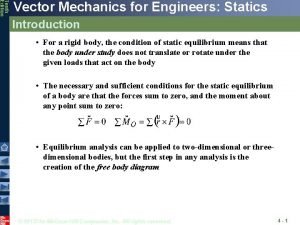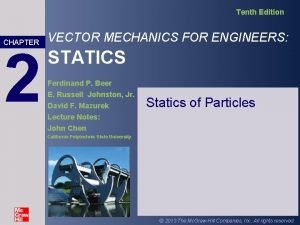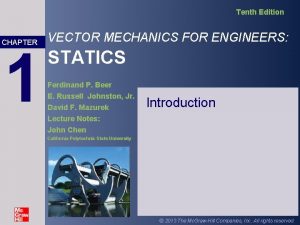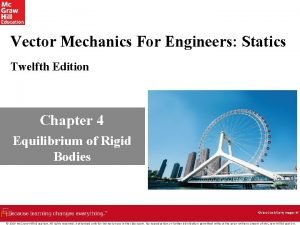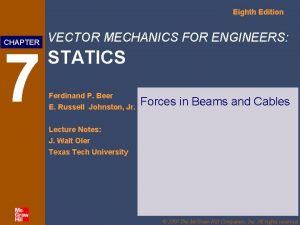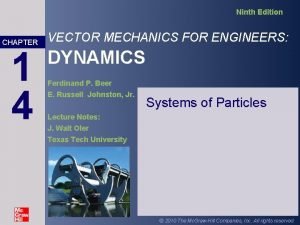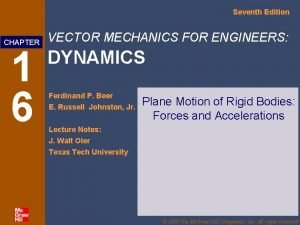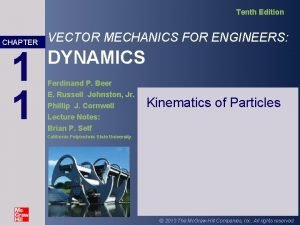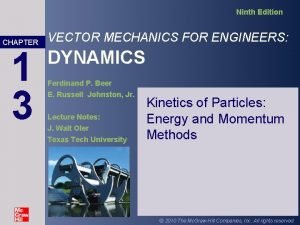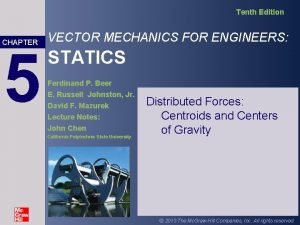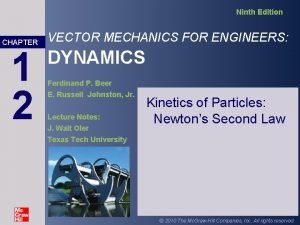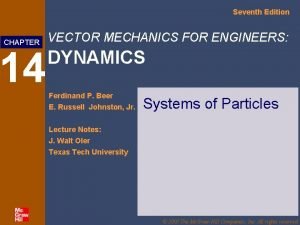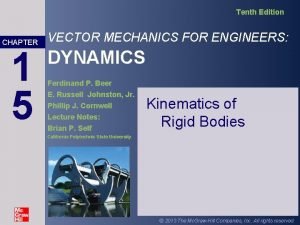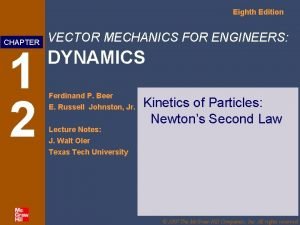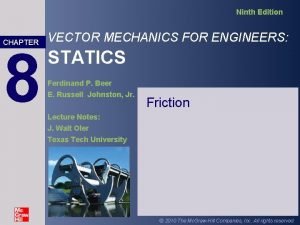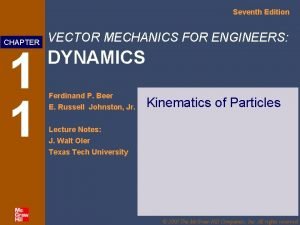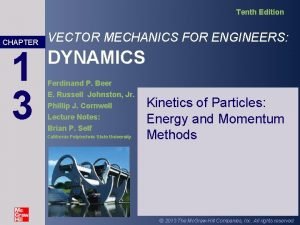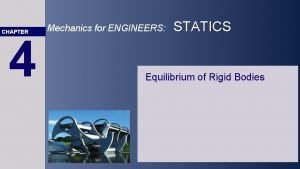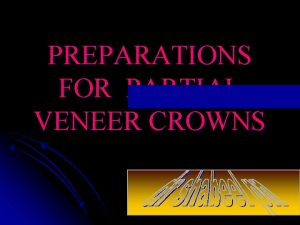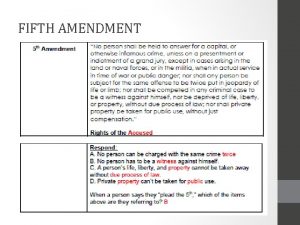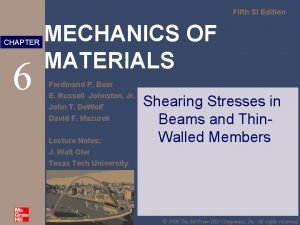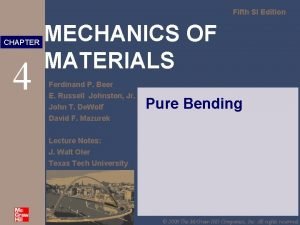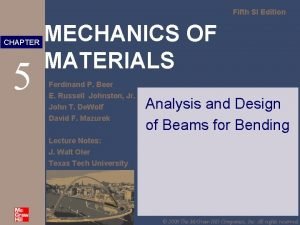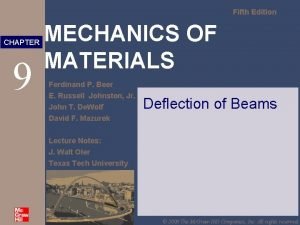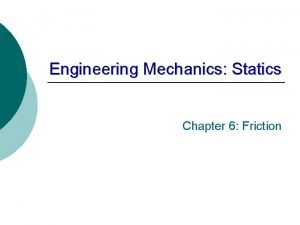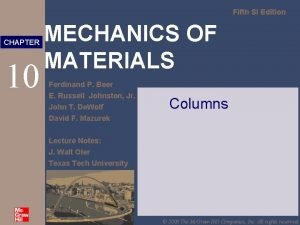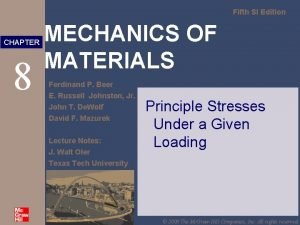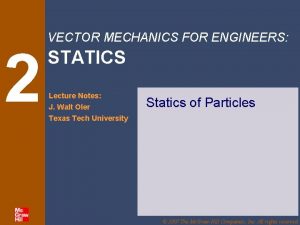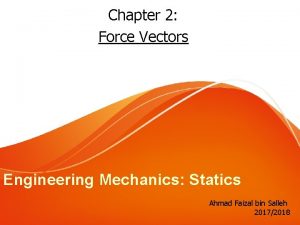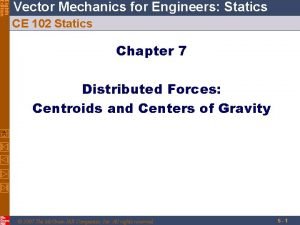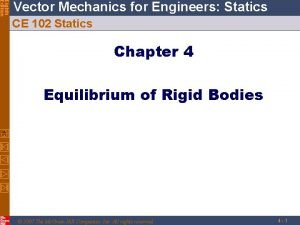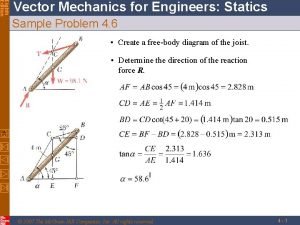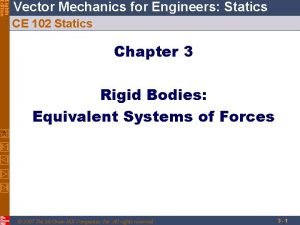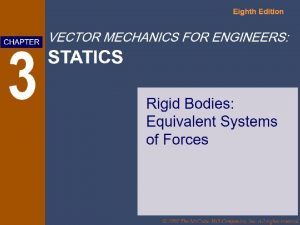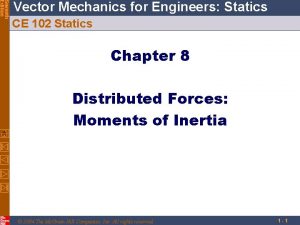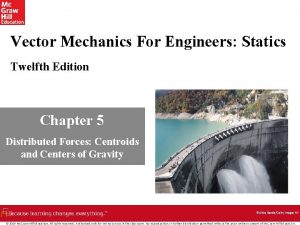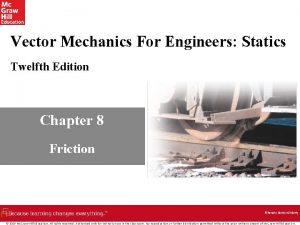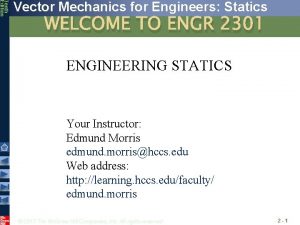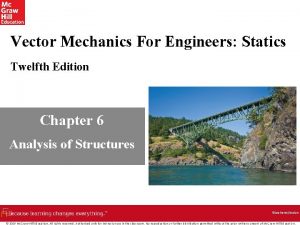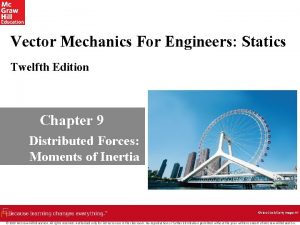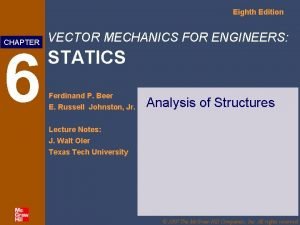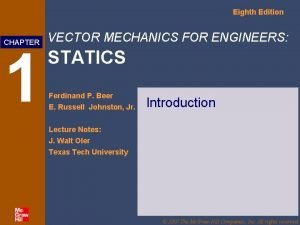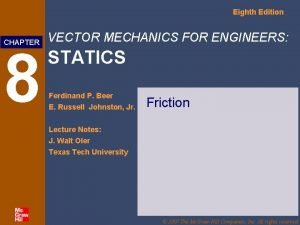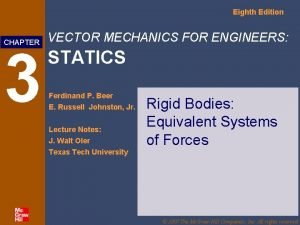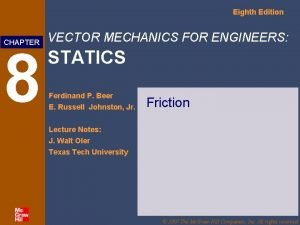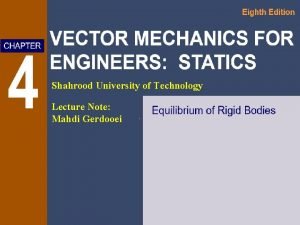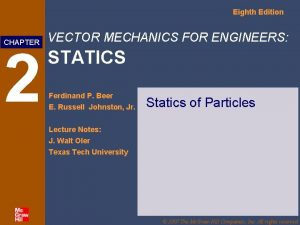Eighth Edition Vector Mechanics for Engineers Statics CE

























































- Slides: 57

Eighth Edition Vector Mechanics for Engineers: Statics CE 102 Statics Chapter 2 Statics of Particles © 2007 The Mc. Graw-Hill Companies, Inc. All rights reserved. 2 -1

Eighth Edition Vector Mechanics for Engineers: Statics Contents Introduction Resultant of Two Forces Vectors Addition of Vectors Resultant of Several Concurrent Forces Sample Problem 2. 1 Sample Problem 2. 2 Rectangular Components of a Force: Unit Vectors Addition of Forces by Summing Components Sample Problem 2. 3 Equilibrium of a Particle Free-Body Diagrams Sample Problem 2. 4 Sample Problem 2. 5 Rectangular Components in Space Sample Problem 2. 6 © 2007 The Mc. Graw-Hill Companies, Inc. All rights reserved. 2 -2

Eighth Edition Vector Mechanics for Engineers: Statics Introduction • The objective for the current chapter is to investigate the effects of forces on particles: - replacing multiple forces acting on a particle with a single equivalent or resultant force, - relations between forces acting on a particle that is in a state of equilibrium. • The focus on particles does not imply a restriction to miniscule bodies. Rather, the study is restricted to analyses in which the size and shape of the bodies is not significant so that all forces may be assumed to be applied at a single point. © 2007 The Mc. Graw-Hill Companies, Inc. All rights reserved. 2 -3

Eighth Edition Vector Mechanics for Engineers: Statics Resultant of Two Forces • force: action of one body on another; characterized by its point of application, magnitude, line of action, and sense. • Experimental evidence shows that the combined effect of two forces may be represented by a single resultant force. • The resultant is equivalent to the diagonal of a parallelogram which contains the two forces in adjacent legs. • Force is a vector quantity. © 2007 The Mc. Graw-Hill Companies, Inc. All rights reserved. 2 -4

Eighth Edition Vector Mechanics for Engineers: Statics Vectors • Vector: parameters possessing magnitude and direction which add according to the parallelogram law. Examples: displacements, velocities, accelerations. • Scalar: parameters possessing magnitude but not direction. Examples: mass, volume, temperature • Vector classifications: - Fixed or bound vectors have well defined points of application that cannot be changed without affecting an analysis. - Free vectors may be freely moved in space without changing their effect on an analysis. - Sliding vectors may be applied anywhere along their line of action without affecting an analysis. • Equal vectors have the same magnitude and direction. • Negative vector of a given vector has the same magnitude and the opposite direction. © 2007 The Mc. Graw-Hill Companies, Inc. All rights reserved. 2 -5

Eighth Edition Vector Mechanics for Engineers: Statics Addition of Vectors • Trapezoid rule for vector addition • Triangle rule for vector addition • Law of cosines, C B C • Law of sines, B • Vector addition is commutative, • Vector subtraction © 2007 The Mc. Graw-Hill Companies, Inc. All rights reserved. 2 -6

Eighth Edition Vector Mechanics for Engineers: Statics Addition of Vectors • Addition of three or more vectors through repeated application of the triangle rule • The polygon rule for the addition of three or more vectors. • Vector addition is associative, • Multiplication of a vector by a scalar © 2007 The Mc. Graw-Hill Companies, Inc. All rights reserved. 2 -7

Eighth Edition Vector Mechanics for Engineers: Statics Resultant of Several Concurrent Forces • Concurrent forces: set of forces which all pass through the same point. A set of concurrent forces applied to a particle may be replaced by a single resultant force which is the vector sum of the applied forces. • Vector force components: two or more force vectors which, together, have the same effect as a single force vector. © 2007 The Mc. Graw-Hill Companies, Inc. All rights reserved. 2 -8

Eighth Edition Vector Mechanics for Engineers: Statics Sample Problem 2. 1 SOLUTION: The two forces act on a bolt at A. Determine their resultant. • Graphical solution - construct a parallelogram with sides in the same direction as P and Q and lengths in proportion. Graphically evaluate the resultant which is equivalent in direction and proportional in magnitude to the diagonal. • Trigonometric solution - use the triangle rule for vector addition in conjunction with the law of cosines and law of sines to find the resultant. © 2007 The Mc. Graw-Hill Companies, Inc. All rights reserved. 2 -9

Eighth Edition Vector Mechanics for Engineers: Statics Sample Problem 2. 1 • Graphical solution - A parallelogram with sides equal to P and Q is drawn to scale. The magnitude and direction of the resultant or of the diagonal to the parallelogram are measured, • Graphical solution - A triangle is drawn with P and Q head-to-tail and to scale. The magnitude and direction of the resultant or of the third side of the triangle are measured, © 2007 The Mc. Graw-Hill Companies, Inc. All rights reserved. 2 - 10

Eighth Edition Vector Mechanics for Engineers: Statics Sample Problem 2. 1 • Trigonometric solution - Apply the triangle rule. From the Law of Cosines, From the Law of Sines, © 2007 The Mc. Graw-Hill Companies, Inc. All rights reserved. 2 - 11

Eighth Edition Vector Mechanics for Engineers: Statics Sample Problem 2. 2 SOLUTION: A barge is pulled by two tugboats. If the resultant of the forces exerted by the tugboats is 5000 N directed along the axis of the barge, determine a) the tension in each of the ropes for a = 45 o, • Find a graphical solution by applying the Parallelogram Rule for vector addition. The parallelogram has sides in the directions of the two ropes and a diagonal in the direction of the barge axis and length proportional to 5000 N. • Find a trigonometric solution by applying the Triangle Rule for vector addition. With the magnitude and direction of the resultant known and the directions of the other two sides parallel to the ropes given, apply the Law of Sines to find the rope tensions. • The angle for minimum tension in rope 2 is determined by applying the Triangle Rule b) the value of a for which the and observing the effect of variations in a. tension in rope 2 is a minimum. © 2007 The Mc. Graw-Hill Companies, Inc. All rights reserved. 2 - 12

Eighth Edition Vector Mechanics for Engineers: Statics Sample Problem 2. 2 • Graphical solution - Parallelogram Rule with known resultant direction and magnitude, known directions for sides. • Trigonometric solution - Triangle Rule with Law of Sines © 2007 The Mc. Graw-Hill Companies, Inc. All rights reserved. 2 - 13

Eighth Edition Vector Mechanics for Engineers: Statics Sample Problem 2. 2 • The angle for minimum tension in rope 2 is determined by applying the Triangle Rule and observing the effect of variations in a. • The minimum tension in rope 2 occurs when T 1 and T 2 are perpendicular. © 2007 The Mc. Graw-Hill Companies, Inc. All rights reserved. 2 - 14

Eighth Edition Vector Mechanics for Engineers: Statics Rectangular Components of a Force: Unit Vectors • May resolve a force vector into perpendicular components so that the resulting parallelogram is a rectangle. are referred to as rectangular vector components and • Define perpendicular unit vectors parallel to the x and y axes. which are • Vector components may be expressed as products of the unit vectors with the scalar magnitudes of the vector components. Fx and Fy are referred to as the scalar components of © 2007 The Mc. Graw-Hill Companies, Inc. All rights reserved. 2 - 15

Eighth Edition Vector Mechanics for Engineers: Statics Addition of Forces by Summing Components • Wish to find the resultant of 3 or more concurrent forces, • Resolve each force into rectangular components • The scalar components of the resultant are equal to the sum of the corresponding scalar components of the given forces. • To find the resultant magnitude and direction, © 2007 The Mc. Graw-Hill Companies, Inc. All rights reserved. 2 - 16

Eighth Edition Vector Mechanics for Engineers: Statics Sample Problem 2. 3 SOLUTION: • Resolve each force into rectangular components. • Determine the components of the resultant by adding the corresponding force components. Four forces act on bolt A as shown. Determine the resultant of the force on the bolt. • Calculate the magnitude and direction of the resultant. © 2007 The Mc. Graw-Hill Companies, Inc. All rights reserved. 2 - 17

Eighth Edition Vector Mechanics for Engineers: Statics Sample Problem 2. 3 SOLUTION: • Resolve each force into rectangular components. • Determine the components of the resultant by adding the corresponding force components. • Calculate the magnitude and direction. © 2007 The Mc. Graw-Hill Companies, Inc. All rights reserved. 2 - 18

Eighth Edition Vector Mechanics for Engineers: Statics Equilibrium of a Particle • When the resultant of all forces acting on a particle is zero, the particle is in equilibrium. • Newton’s First Law: If the resultant force on a particle is zero, the particle will remain at rest or will continue at constant speed in a straight line. • Particle acted upon by two forces: - equal magnitude - same line of action - opposite sense • Particle acted upon by three or more forces: - graphical solution yields a closed polygon - algebraic solution © 2007 The Mc. Graw-Hill Companies, Inc. All rights reserved. 2 - 19

Eighth Edition Vector Mechanics for Engineers: Statics Free-Body Diagrams Space Diagram: A sketch showing the physical conditions of the problem. Free-Body Diagram: A sketch showing only the forces on the selected particle. © 2007 The Mc. Graw-Hill Companies, Inc. All rights reserved. 2 - 20

Eighth Edition Vector Mechanics for Engineers: Statics Sample Problem 2. 4 SOLUTION: • Construct a free-body diagram for the particle at the junction of the rope and cable. • Apply the conditions for equilibrium by creating a closed polygon from the forces applied to the particle. In a ship-unloading operation, a 3500 -N automobile is supported by a cable. A rope is tied to the cable and pulled to center the automobile over its intended position. What is the tension in the rope? • Apply trigonometric relations to determine the unknown force magnitudes. © 2007 The Mc. Graw-Hill Companies, Inc. All rights reserved. 2 - 21

Eighth Edition Vector Mechanics for Engineers: Statics Sample Problem 2. 4 SOLUTION: • Construct a free-body diagram for the particle at A. • Apply the conditions for equilibrium. • Solve for the unknown force magnitudes. © 2007 The Mc. Graw-Hill Companies, Inc. All rights reserved. 2 - 22

Eighth Edition Vector Mechanics for Engineers: Statics Sample Problem 2. 5 SOLUTION: • Choosing the hull as the free body, draw a free-body diagram. It is desired to determine the drag force at a given speed on a prototype sailboat hull. A model is placed in a test channel and three cables are used to align its bow on the channel centerline. For a given speed, the tension is 40 N in cable AB and 60 N in cable AE. • Express the condition for equilibrium for the hull by writing that the sum of all forces must be zero. • Resolve the vector equilibrium equation into two component equations. Solve for the two unknown cable tensions. Determine the drag force exerted on the hull and the tension in cable AC. © 2007 The Mc. Graw-Hill Companies, Inc. All rights reserved. 2 - 23

Eighth Edition Vector Mechanics for Engineers: Statics Sample Problem 2. 5 SOLUTION: • Choosing the hull as the free body, draw a free-body diagram. • Express the condition for equilibrium for the hull by writing that the sum of all forces must be zero. © 2007 The Mc. Graw-Hill Companies, Inc. All rights reserved. 2 - 24

Eighth Edition Vector Mechanics for Engineers: Statics Sample Problem 2. 5 • Resolve the vector equilibrium equation into two component equations. Solve for the two unknown cable tensions. r r r T AB = -(40 N )sin 60. 26° i + (40 N )cos 60. 26° j r r = -(34. 73 N )i + (19. 84 N ) j r r r T AC = T AC sin 20. 56° i + T AC cos 20. 56° j r r = 0. 3512 T AC i + 0. 9363 T AC j r r T = -(60 N) j r r FD = FD i r R=0 r = (- 34. 73 + 0. 3512 T AC + FD )i r + (19. 84 + 0. 9363 T AC - 60 ) j © 2007 The Mc. Graw-Hill Companies, Inc. All rights reserved. 2 - 25

Eighth Edition Vector Mechanics for Engineers: Statics Sample Problem 2. 5 This equation is satisfied only if each component of the resultant is equal to zero. © 2007 The Mc. Graw-Hill Companies, Inc. All rights reserved. 2 - 26

Eighth Edition Vector Mechanics for Engineers: Statics Rectangular Components in Space • The vector is contained in the plane OBAC. • Resolve into horizontal and vertical components. • Resolve into rectangular components. Fx = Fh cos f = F sin q y cos f F z = Fh sin f = F sin q y sin f © 2007 The Mc. Graw-Hill Companies, Inc. All rights reserved. 2 - 27

Eighth Edition Vector Mechanics for Engineers: Statics Rectangular Components in Space • With the angles between • and the axes, is a unit vector along the line of action of and are the direction cosines for © 2007 The Mc. Graw-Hill Companies, Inc. All rights reserved. 2 - 28

Eighth Edition Vector Mechanics for Engineers: Statics Rectangular Components in Space Direction of the force is defined by the location of two points, © 2007 The Mc. Graw-Hill Companies, Inc. All rights reserved. 2 - 29

Eighth Edition Vector Mechanics for Engineers: Statics Sample Problem 2. 6 SOLUTION: • Based on the relative locations of the points A and B, determine the unit vector pointing from A towards B. • Apply the unit vector to determine the components of the force acting on A. The tension in the guy wire is 2500 N. Determine: • Noting that the components of the unit vector are the direction cosines for the vector, calculate the corresponding angles. a) components Fx, Fy, Fz of the force acting on the bolt at A, b) the angles qx, qy, qz defining the direction of the force © 2007 The Mc. Graw-Hill Companies, Inc. All rights reserved. 2 - 30

Eighth Edition Vector Mechanics for Engineers: Statics Sample Problem 2. 6 SOLUTION: • Determine the unit vector pointing from A towards B. • Determine the components of the force. © 2007 The Mc. Graw-Hill Companies, Inc. All rights reserved. 2 - 31

Eighth Edition Vector Mechanics for Engineers: Statics Sample Problem 2. 6 • Noting that the components of the unit vector are the direction cosines for the vector, calculate the corresponding angles. © 2007 The Mc. Graw-Hill Companies, Inc. All rights reserved. 2 - 32

Problem 2. 7 240 lb 30 o a 75 lb A 50 o 75 lb The direction of the 75 -lb forces may vary, but the angle between the forces is always 50 o. Determine the value of a for which the resultant of the forces acting at A is directed horizontally to the left. 33

Problem 2. 7 Solving Problems on Your Own 240 lb 30 o a 75 lb A 50 o 75 lb The direction of the 75 -lb forces may vary, but the angle between the forces is always 50 o. Determine the value of a for which the resultant of the forces acting at A is directed horizontally to the left. 1. Determine the resultant R of two or more forces. 2. Draw a parallelogram with the applied forces as two adjacent sides and the resultant as the included diagonal. 3. Set the resultant, or sum of the forces, directed horizontally. 34

Problem 2. 7 Solution 240 lb 30 o a 75 lb Determine the resultant R of two or more forces. A We first Replace the two 75 -lb forces by their resultant R 1, using the triangle rule. 50 o 75 lb a 25 o 50 o 25 o R 1 = 2(75 lb) cos 25 o = 135. 95 lb R 1 = 135. 95 lb a +25 o 35

Problem 2. 7 Solution Draw a parallelogram with the applied forces as two adjacent sides and the resultant as the included diagonal. Set the resultant, or sum of the forces, directed horizontally. R 2 30 o 240 lb a+25 o R 1 = 135. 95 lb Consider the resultant R 2 of R 1 and the 240 -lb force and recall that R 2 must be horizontal and directed to the left. Law of sines: sin(a+25 o) sin(30 o) = 240 lb 135. 95 lb o (240 lb) sin(30 ) o sin(a+25 ) = 135. 95 lb a + 25 o = 61. 97 o = 0. 88270 a = 37. 0 o 36

Problem 2. 8 y 360 mm D C O 500 mm z 450 mm B A 320 mm 600 mm x A container of weight W = 1165 N is supported by three cables as shown. Determine the tension in each cable. 37

Problem 2. 8 y 360 mm D C 450 mm O 500 mm z Solving Problems on Your Own B A 320 mm 600 mm x A container of weight W = 1165 N is supported by three cables as shown. Determine the tension in each cable. 1. Draw a free-body diagram of the particle. This diagram shows the particle and all the forces acting on it. 2. Resolve each of the forces into rectangular components. Follow the method outlined in the text. F F = F l = (dx i + dy j + dz k) d 38

Problem 2. 8 y 360 mm D C 450 mm O 500 mm z Solving Problems on Your Own B A 320 mm 600 mm x A container of weight W = 1165 N is supported by three cables as shown. Determine the tension in each cable. 3. Set the resultant, or sum, of the forces exerted on the particle equal to zero. You will obtain a vectorial equation consisting of terms containing the unit vectors i, j, and k. Three scalar equations result, which can be solved for the unknowns. 39

Problem 2. 8 Solution Draw a free-body diagram of the particle. y 360 mm C D O TAC 500 mm z TAD A 450 mm B TAB SF=0 320 mm 600 mm TAB + TAC + TAD + W = 0 x W = _ (1165 N) j AB = (450 mm)i + (600 mm)j AB = 750 mm AC = (600 mm)j _ (320 mm)k AC = 680 mm AD = (_500 mm)i + (600 mm)j + (360 mm)k 40 AD = 860 mm

Problem 2. 8 Solution y 360 mm C D O TAC 500 mm TAD z A W = _ (1165 N) j TAC = TAC l. AC = TAC Resolve each of the forces into rectangular components. 450 mm B TAB 320 mm 600 mm x ( TAB = TAB l. AB = TAB AB = AB 600 450 j TAB = i+ = 750 = (0. 6 i + 0. 8 j) TAB ( ) ) ( ) 600 _ 320 AC 15 j _ 8 k = 680 j TAC k TAC= 680 17 AC 17 AD 500 600 360 k TAD = i+ TAD = TAD l. AD = TAD = j+ 860 860 AD 25 30 18 k TAD i+ = j+ 43 43 41 43 ( ( ) )

Problem 2. 8 Solution y 360 mm C D O TAC 500 mm z TAD A W = _ (1165 N) j B TAB 0. 6 TAB _ 25 TAD = 0 43 0. 8 TAB + _ Set the resultant, or sum, of the forces exerted on the particle equal to zero. 450 mm 320 mm 600 mm x Substitution into S F = 0, factor i, j, k and set their coefficients to zero: TAB = 0. 9690 TAD 15 30 T _ TAC + AD 1165 N = 0 17 43 18 T = 0 8 TAC + 43 AD 17 + TAC = 0. 8895 TAD (1) (2) (3) 42

Problem 2. 8 Solution y 360 mm C D O TAC 500 mm z TAD A W = _ (1165 N) j 450 mm B TAB 320 mm 600 mm Substitution for TAB and TAC from (1) and (3) into (2): x 15 30 x 0. 8895 + )TAD _ 1165 N = 0 17 43 TAD = 516 N 2. 2578 TAD _ 1165 N = 0 ( 0. 8 x 0. 9690 + From (1): TAB = 0. 9690 (516 N) TAB = 500 N From (3): TAC = 0. 8895 (516 N) TAC = 459 N 43

Problem 2. 9 y A 56 ft D a O B 20 o 50 o z C x Cable AB is 65 ft long, and the tension in that cable is 3900 lb. Determine (a) the x, y, and z components of the force exerted by the cable on the anchor B, (b) the angles qx, qy, and qz defining the direction of that force. 44

Problem 2. 9 y Solving Problems on Your Own A 56 ft D a O B 20 o 50 o z C x Cable AB is 65 ft long, and the tension in that cable is 3900 lb. Determine (a) the x, y, and z components of the force exerted by the cable on the anchor B, (b) the angles qx, qy, and qz defining the direction of that force. 1. Determine the rectangular components of a force defined by its magnitude and direction. If the direction of the force F is defined by the angles qy and f, projections of F through these angles or their components will yield the components of F. 45

Problem 2. 9 y Solving Problems on Your Own A 56 ft D a O B 20 o 50 o z C x Cable AB is 65 ft long, and the tension in that cable is 3900 lb. Determine (a) the x, y, and z components of the force exerted by the cable on the anchor B, (b) the angles qx, qy, and qz defining the direction of that force. 2. Determine the direction cosines of the line of action of a force. The direction cosines of the line of action of a force F are determined by dividing the components of the force by F. Fx Fy Fz cos qx= cos qy= cos qz= F F F 46

A qy 56 ft Problem 2. 9 Solution y Determine the direction cosines of the line of action of a force. 65 ft F Fy From triangle AOB: cos qy = 56 ft = 0. 86154 65 ft qy = 30. 51 o Fx B O 20 o Fz (a) Fx = _ F sin qy cos 20 o = _ (3900 lb) sin 30. 51 o cos 20 o Fx = _1861 lb z x Fy = + F cos qy = (3900 lb)(0. 86154) Fy = + 3360 lb Fz = + (3900 lb) sin 30. 51 o sin 20 o Fz = + 677 lb 47

A qy 56 ft Problem 2. 9 Solution y Determine the direction cosines of the line of action of a force. 65 ft F Fy Fx B O _ Fx 1861 lb (b) cos qx = = F 3900 lb cos qx = _ 0. 4771 qx = 118. 5 o 20 o Fz From above (a): qy = 30. 5 o x Fz cos qz = F 677 lb = + 0. 1736 3900 lb qz = 80. 0 o 48

Problem 2. 10 B A 8. 5 ft 12 ft C 396 lb 9 ft Two cables are tied together at C and loaded as shown. determine the tension (a) in cable AC, (b) in cable BC. 7. 5 ft 49

Problem 2. 10 B A 8. 5 ft 12 ft C 396 lb 7. 5 ft Solving Problems on Your Own 9 ft Two cables are tied together at C and loaded as shown. determine the tension (a) in cable AC, (b) in cable BC. 1. Draw a free-body diagram of the particle. This diagram shows the particle and all the forces acting on it. 2. Set the resultant, or sum, of the forces exerted on the particle equal to zero. You will obtain a vectorial equation consisting of terms containing the unit vectors i, j, and k. Three scalar equations result, which can be solved for the unknowns. 50

Problem 2. 10 Solution FREE BODY C: y Draw a free-body diagram of the particle. TBC TAC 3. 5 12. 5 8. 5 12 7. 5 4 396 lb S Fx = 0 : x Set the resultant, or sum, of the forces exerted on the particle equal to zero. 7. 5 12 T TBC = 0 + AC 8. 5 12. 5 TBC = 1. 088 TAC S Fy = 0 : 3. 5 4 TAC + 8. 5 TBC 12. 5 396 lb = 0 51

y Problem 2. 10 Solution TBC TAC 3. 5 12. 5 8. 5 12 7. 5 4 x 396 lb (a) Substitute for TBC: 3. 5 4 _ TAC + (1. 088 T ) 396 lb = 0 AC 8. 5 12. 5 (b) (0. 280 + 0. 512) TAC _ 396 lb = 0 TAC = 500 lb TBC = 1. 088 (500 lb) TBC = 544 lb 52

Problem 2. 11 y x P A O Q z B z 20 in x Collars A and B are connected by a 25 -in. -long wire and can slide freely on frictionless rods. If a 60 -lb force Q is applied to collar B as shown, Determine (a) the tension in the wire when x = 9 in. , (b) the corresponding magnitude of the force P required to maintain the equilibrium of the system. 53

y Problem 2. 11 x Solving Problems on Your Own P A O Q z B z 20 in x Collars A and B are connected by a 25 -in. -long wire and can slide freely on frictionless rods. If a 60 -lb force Q is applied to collar B as shown, Determine (a) the tension in the wire when x = 9 in. , (b) the corresponding magnitude of the force P required to maintain the equilibrium of the system. 1. Draw a free-body diagram of the particle. This diagram shows the particle and all the forces acting on it. 54

y Problem 2. 11 x Solving Problems on Your Own P A O Q z B z 20 in x Collars A and B are connected by a 25 -in. -long wire and can slide freely on frictionless rods. If a 60 -lb force Q is applied to collar B as shown, Determine (a) the tension in the wire when x = 9 in. , (b) the corresponding magnitude of the force P required to maintain the equilibrium of the system. 2. Set the resultant, or sum, of the forces exerted on the particle equal to zero. You will obtain a vectorial equation consisting of terms containing the unit vectors i, j, and k. Three scalar equations result, which can be solved for the unknowns. 55

y Problem 2. 11 Solution x P l. AB A O Q z B z 20 in x x i _ (20 in) j + z k 25 in Draw a free-body diagram of the particle. S F = 0: P i + Ny j + Nz k + TAB l. AB = 0 A Pi TAB l. AB _ Free Body: Collar A Ny j Nz k = AB AB = Substitute for l. AB and set coefficients of i equal to zero: P _ TAB x = 0 25 (1) 56

Ny j _ B TAB l. AB Problem 2. 11 Solution Free Body: Collar B S F = 0: (60 lb) k + Nx i + Ny j _ TAB l. AB = 0 Nx i Substitute for l. AB and set coefficients of k equal to zero: Q = (60 lb) k 60 _ TAB z = 0 25 (2) (a) Since x = 9 in. : (9 in)2 + (20 in) 2 + z 2 = (25 in) 2 From eq. (2): 60 _ TAB (12) 25 = 0 (125. 0 lb)(9 in) (b) From eq. (1): P = 25 in z = 12 in TAB = 125. 0 lb P = 45. 0 lb 57
 Mechanics
Mechanics Vector mechanics for engineers statics 10th edition
Vector mechanics for engineers statics 10th edition Vector mechanics for engineers statics 10th edition
Vector mechanics for engineers statics 10th edition Vector mechanics for engineers 10th edition
Vector mechanics for engineers 10th edition Vector mechanics for engineers statics 12th
Vector mechanics for engineers statics 12th Vector mechanics for engineers statics 12th
Vector mechanics for engineers statics 12th Vector mechanics for engineers chapter 7 solutions
Vector mechanics for engineers chapter 7 solutions Vector mechanics for engineers: dynamics
Vector mechanics for engineers: dynamics Vector mechanics for engineers dynamics 12th
Vector mechanics for engineers dynamics 12th Vector mechanics for engineers: dynamics
Vector mechanics for engineers: dynamics Vector mechanics for engineers: dynamics
Vector mechanics for engineers: dynamics Vector mechanics for engineers
Vector mechanics for engineers Vector mechanics for engineers dynamics 12th
Vector mechanics for engineers dynamics 12th Vector mechanics for engineers: dynamics
Vector mechanics for engineers: dynamics At the instant shown the length of the boom ab
At the instant shown the length of the boom ab Vector mechanics for engineers: dynamics
Vector mechanics for engineers: dynamics Vector mechanics for engineers
Vector mechanics for engineers Vector mechanics for engineers dynamics 12th
Vector mechanics for engineers dynamics 12th Vector mechanics for engineers dynamics 12th
Vector mechanics for engineers dynamics 12th Psychology eighth edition david g myers
Psychology eighth edition david g myers Operations management eighth edition
Operations management eighth edition Psychology eighth edition david g myers
Psychology eighth edition david g myers Rocker statics
Rocker statics Moment of force engineering mechanics
Moment of force engineering mechanics Engineering mechanics: statics in si units
Engineering mechanics: statics in si units The eighth wonder
The eighth wonder Nearest quarter inch
Nearest quarter inch Criminal justice lesson
Criminal justice lesson Three quarter partial coverage crown
Three quarter partial coverage crown The fifth, sixth, seventh, and eighth amendments protect *
The fifth, sixth, seventh, and eighth amendments protect * What's the 5th amendment
What's the 5th amendment Anagram of eighth
Anagram of eighth Eighth amendment excessive bail
Eighth amendment excessive bail What is the eighth commandment catholic
What is the eighth commandment catholic Eighth planet from the sun
Eighth planet from the sun Eighth letter of the alphabet
Eighth letter of the alphabet Fluid mechanics fundamentals and applications
Fluid mechanics fundamentals and applications Mechanics of materials chapter 6
Mechanics of materials chapter 6 Mechanic of materials
Mechanic of materials Chapter 5 mechanics of materials solutions
Chapter 5 mechanics of materials solutions Ferdinand beer
Ferdinand beer Friction chapter in engineering mechanics
Friction chapter in engineering mechanics Mechanics of materials chapter 10 solutions pdf
Mechanics of materials chapter 10 solutions pdf Mechanics of materials 6th edition beer solution chapter 3
Mechanics of materials 6th edition beer solution chapter 3 Mechanics of materials
Mechanics of materials Beer johnston
Beer johnston Vector mechanics
Vector mechanics Solve the vector product of 100j x 100k =?
Solve the vector product of 100j x 100k =? Using mis 10th edition
Using mis 10th edition Zulily case study
Zulily case study Vector directed line segment
Vector directed line segment Fsica
Fsica How is vector resolution the opposite of vector addition
How is vector resolution the opposite of vector addition Define position vector.
Define position vector. Trög för kemist
Trög för kemist Vad är ett minoritetsspråk
Vad är ett minoritetsspråk Fimbrietratt
Fimbrietratt Samlade siffror för tryck
Samlade siffror för tryck
